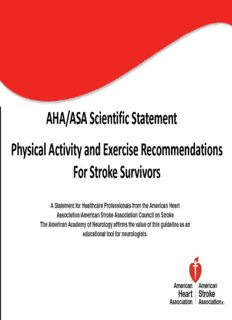
Physical Activity and Exercise Recommendations For Stroke Survivors AHA/ASA Scientific Statement PDF
Preview Physical Activity and Exercise Recommendations For Stroke Survivors AHA/ASA Scientific Statement
AHA/ASA Scientific Statement Physical Activity and Exercise Recommendations For Stroke Survivors A Statement for Healthcare Professionals from the American Heart Association/American Stroke Association Council on Stroke The American Academy of Neurology affirms the value of this guideline as an educational tool for neurologists. 0 Writing Committee Sandra A. Billinger, PT, PhD, FAHA, Chair Ross Arena, PT, PhD, FAHA, Co-Chair Julie Bernhardt, PT, PhD Janice J. Eng, BSc, PT/OT, PhD Barry A. Franklin, PhD, FAHA Cheryl Mortag Johnson, OTR Marilyn MacKay-Lyons, BSc, MScPT, PhD Richard F. Macko, MD Gillian E. Mead, MD, MA, FRCP Elliott J. Roth, MD, FAHA Marianne Shaughnessy, PhD, RN,CRNP Ada Tang, PT, PhD On behalf of the American Heart Association Stroke Council; Councils on Cardiovascular and Stroke Nursing; Lifestyle and Cardiometabolic Health (formerly Nutrition; Physical Activity, and Metabolism); Epidemiology and Prevention; and Clinical Cardiology 1 ©2014 American Heart Association, Inc. Purpose of Scientific Statement • This statement provides an overview of the evidence on physical activity and exercise recommendations for stroke survivors. • It guides practitioners to understand the benefits of physical activity and thus recommend and prescribe exercise throughout the stages of stroke recovery. 2 ©2014 American Heart Association, Inc. Stroke Council Professional Education Committee This slide presentation was developed by a member of the Stroke Council Professional Education Committee. Connie F. Parliament, RN, MSN, CNRN 3 ©2014 American Heart Association, Inc. Citation Information Physical Activity and Exercise Recommendations for Stroke Survivors Link: http://stroke.ahajournals.org/lookup/doi/10.1161/STR.0000000000000022 Key words included in the article: aerobic exercise; exercise, physical activity; rehabilitation; strength training Citation: Billinger SA, Arena R, Bernhardt J, Eng JJ, Franklin BA, Johnson CM, MacKay-Lyons M, Macko RF, Mead GE, Roth EJ, Shaughnessy M, Tang A; on behalf of the American Heart Association Stroke Council, Council on Cardiovascular and Stroke Nursing, Council on Lifestyle and Cardiometabolic Health, Council on Epidemiology and Prevention, and Council on Clinical Cardiology. Physical activity and exercise recommendations for stroke survivors: a statement for healthcare professionals from the American Heart Association/American Stroke Association [published online ahead of print May 20, 2014]. Stroke. doi: 10.1161/STR.0000000000000022. 4 ©2014 American Heart Association, Inc. Scientific Statement Scientific Paper Methods Members of the writing group were appointed by the AHA Stroke Council's Scientific Statement Oversight Committee and the AHA's Manuscript Oversight Committee. The writers utilized literature reviews, references to published clinical and epidemiology studies, morbidity and mortality reports, clinical and public health guidelines, authoritative statements, personal files, and expert opinion to summarize existing evidence and indicate gaps in current knowledge. Results The body of evidence clearly supports the use of exercise training (both aerobic and strength training) for stroke survivors. Physical activity goals and exercise prescription for the stroke survivors need to be customized for the individual to maximize long- term adherence. Conclusion The promotion of physical activity in stroke survivors should emphasize low- to moderate-intensity aerobic activity, muscle-strengthening activity, reducing sedentary behavior, and risk management for secondary prevention of stroke. Key Words: aerobic exercise; exercise, physical activity; rehabilitation; strength training 5 ©2014 American Heart Association, Inc. Introduction • 795,000 strokes (new and recurrent) in the US per year • Affects 1 person every 40 minutes • About one quarter are recurrent strokes • 7 million living with stroke Estimated: • 4 million will have a stroke by 2030 (25% increase from 2010) • Stroke remains a leading cause of long-term disability in the United States. 6 ©2014 American Heart Association, Inc. Introduction continued Framingham Study: • Lifetime stroke risk is 1 in 5 for women and 1 in 6 for men among those 55 to 75 years of age. • American adults with disability are likely to be obese, to smoke, and to be physically inactive. • Stroke continues to be the fourth leading cause of death in the United States when viewed separately for other cardiovascular diseases. 7 ©2014 American Heart Association, Inc. Stroke Survivors: • Often become deconditioned and predisposed to a sedentary lifestyle • Are at increased risk for falls • Are at risk for recurrent stroke and other CVDs • Studies have found that participation in physical activity levels are lower than those of elderly persons with other chronic health conditions. 8 ©2014 American Heart Association, Inc. Defining Exercise and Physical Activity Exercise Any bodily movement produced by skeletal muscles that results in energy expenditure Physical Is a subset of physical activity that is planned, Activity structured, and repetitive and has as a final or an intermediate objective the improvement or maintenance of physical fitness 9 ©2014 American Heart Association, Inc.
Description: